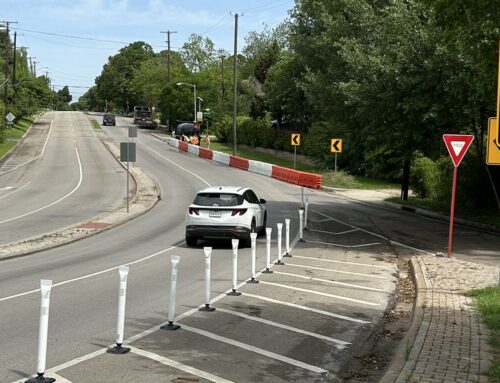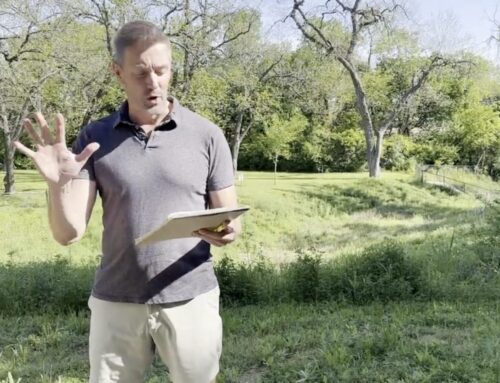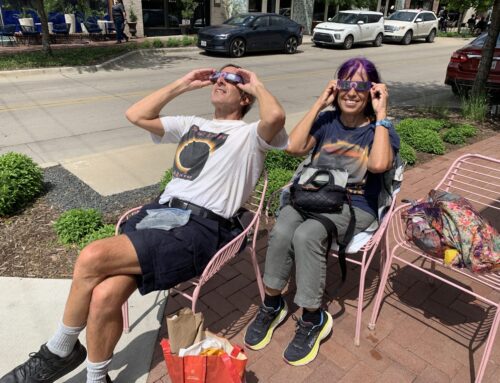A video captured by a spectator of a car sliding at a blocked intersection by U.S. Highway 75 while a passenger hangs out the side window holding a flag.
YOU CAN HEAR IT FROM MILES AWAY.
Engines roaring, tires screeching and spewing clouds of smoke, spectators yelling and cheering. Sometimes fireworks and gunshots ring out when the crowd gets especially excited.
Reports of street racing from the Dallas Police Department shot up in 2020, from 4,867 in 2019, to 8,441 last year, and 911 calls related to speeding and racing have increased every year since 2016. Metrics from the first part of 2021 show no signs of reports decreasing.
“The number one phone call I get from people is about street racing,” says City Councilman Chad West.
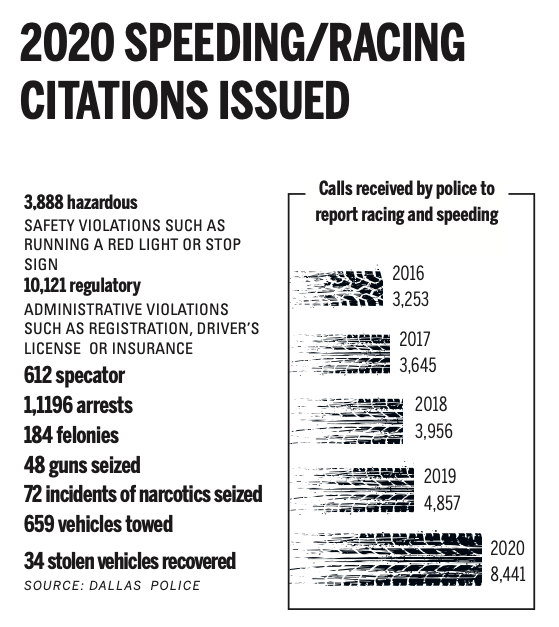
Street racing and car stunts are by no means new phenomena, but last year, intersection takeovers, excessive speeding and extremely loud vehicles started to infiltrate the Downtown area. People noticed the problem, and DPD patrols increased; lane reductions at key intersections and temporary stop signs were also implemented to calm traffic.
“Curbing street racing in the city became a priority, and it worked,” West says. “But since it worked, it got pushed to the neighborhoods, including Oak Cliff.”
DPD’s limited resources mean officers find it hard to keep up. West says that on any given weekend, there are anywhere from 1,000-2,000 street racers in the City, but only 800-1,000 officers on patrol.
“These guys are smart. They often have radios. They know when cops are onto them so they can elude us.”
Also hampering the DPD is a strict policy on high-speed pursuit that was revised in 2011 after the determination that high-speed chases, which often were occurring over misdemeanor offenses, resulted in increased injuries and deaths. Now officers only engage in pursuit when they can identify a threat of physical force or violence.
And like almost every other aspect of life, the pandemic played a part.
“It’s a problem that has gotten worse with COVID,” West says. “I’ve talked to people who say they are just bored. They’re not able to do as much. It’s an outlet for them to get out of the house and do something.”
Crashes related to racing and drifting in intersections have resulted in property damage, injury and even death for participants and bystanders. Last year, one person died after a racing-related accident on Southlink Drive.
The dangers of reckless driving are a top concern for many Oak Cliff residents. In an Oak Cliff public safety survey created by the City’s Public Safety Advisory Committee, 570 people responded, and 61% put “address illegal car racing and vagrancy” among their top five priorities regarding neighborhood safety. In zip codes 75211 and 75224, illegal car racing and vagrancy was the No. 1 issue.
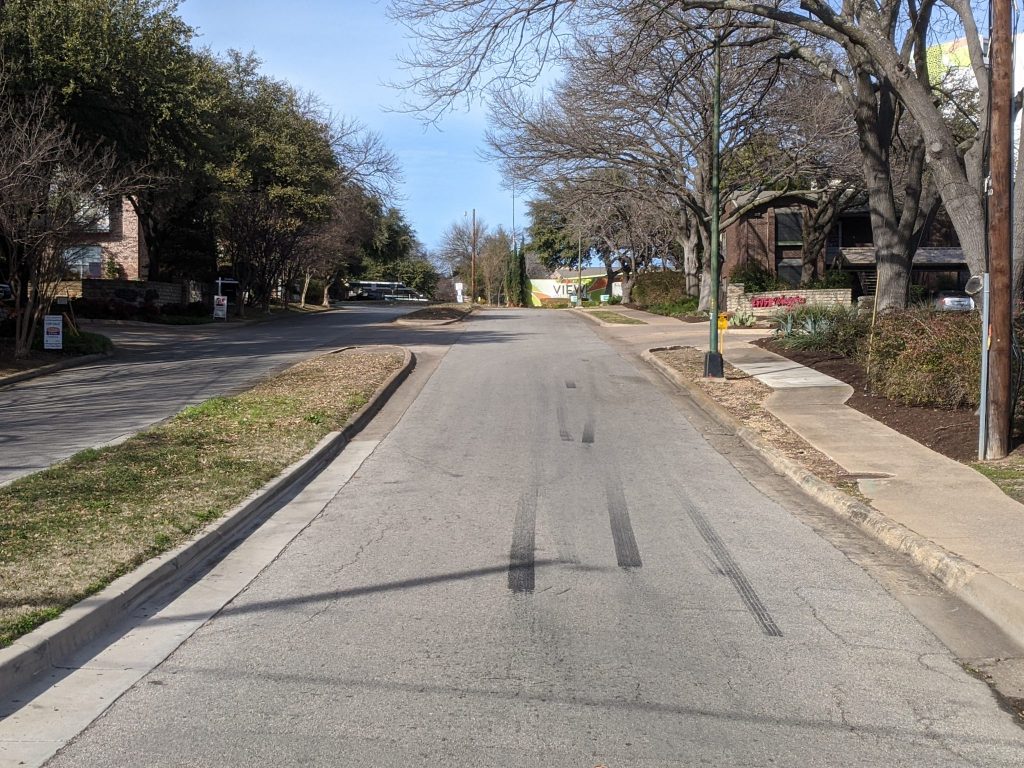
Skid marks line the street leading up to the View at West Kessler apartment complex, where until recently, reports of loud cars and peel-outs had gone unanswered for months. Photo by Connor Henry.
Racing vs. takeovers
Labeling it all “street racing” is an oversimplification.
“There’s actual street racing, and then there’s the parking lot takeovers, highway-takeover group,” says a professional hot rod shop manager who did not want his name used.
He says he first became involved with street racing as a teenager.
“I used to go out with my friend’s dad,” the manager says. “We’d go out to the track, and then after, go out to the street and try to find street races.”
He says street races originally happened off the main roads and usually late at night, and it was a pretty big part of his life.
“That’s what I would spend my money on,” he says. “I’ve done every aspect of it: the paint, chassis, motors, interior.”
To him, street racing is nothing like intersection takeovers.
“That’s more of a gathering of people with cars, and those are the ones that end up giving everyone a bad name. Those are the ones that are out of control,” the manager says.
The takeovers, also known as slideshows, involve cars blocking an intersection or parking lot, and they attract people mostly under the age of 25. Drivers swing cars around in circles, burning rubber and often coming close to spectators. These events tend to draw larger crowds.
Spectators cluster together while a car spins around them at high speed during a takeover at Noel and Spring Valley.
A Dallas resident who sometimes goes to takeovers tells a different story.
“They don’t let just anyone go in the pit,” he says, referring to the middle of the intersection. “It’s only extremely good drivers. They go and practice all the time.”
The resident, who also didn’t want to be identified, says he stumbled across his first takeover when he was out late one night.
“I was curious about it, so I looked on social media, and I saw some accounts. You have to message proof that you saw street racing, or something that proves you’re not gonna rat them out to get in some groups,” he says. “I’m not a car guy myself. I just get bored and want to go watch it.”
Takeovers are typically organized on social media. Private Instagram accounts post scheduled events, and people communicate through direct messaging about which cars will block off the streets and who will watch for police.
A car throws out a cloud of smoke while spinning out. Street racing is currently a priority two call, which means a 12-minute response time for officers to get to the scene.
“These guys are smart,” West says. “They often have radios. They know when cops are onto them so they can elude us.”
West did a ride-along with DPD Lt. Eric Roman one night to see the situation for himself. “We only spotted them once, and I wanted to go in, but we didn’t have backup. By the time backup arrived, they were gone,” he says.
“Even if we focused every officer, we cannot police our way out of it. We have to come up with other solutions.”
Since DPD reporting doesn’t differentiate between street racing and sliding, it’s hard to say which is more prevalent or more dangerous.
Taken together, though, reckless driving seems to have taken over Dallas. Assistant city manager for public safety Jon Fortune said that citywide in 2020, DPD issued more than 4,000 hazardous citations, 10,000 regular citations and 600 spectator citations and made more than 1,200 arrests related to reckless driving. Police towed nearly 700 vehicles and recovered 34 stolen vehicles during that period.
Last May, City Council passed an ordinance to impound cars and ticket spectators. Even with an uptick in citations, there was no noticeable decrease in behavior.
With DPD’s policy on pursuit, drivers typically aren’t caught. Even when they are, they face relatively low fines. Their vehicles are impounded, but the perpetrators must be convicted for their cars to be seized, and it can take multiple convictions for that to happen.
Some on City Council want statewide legislation to make it easier for cities to seize cars and punish offenders, but some of the issue goes back to the disparity between the number of offenders and the number of police officers on call on a given night.
“Even if we focused every officer, we cannot police our way out of it,” West says. “We have to come up with other solutions.”
Other solutions
Racers, swingers and supporters agree that street racing and sliding come with unavoidable risks. Some suggest finding a space where people can do it more safely.
That’s the view shared by Ricardo Anderson, a self-identified “swinger.” Anderson sent an email to council member David Blewett last year asking for the City’s help in creating a “special spot” to get swingers off the streets.
“Trust me, we getting tired of running from y’all,” he wrote. “Us swingers want to be safe as well, left alone in peace … we previously had a secret spot that DPD found and decided to raid it a few months back … we just want our spot back.”
There’s a petition on Change.org from TSNLS Dallas, an Instagram account that posts videos of street racing, requesting “a legal lot to slide so NOBODY gets hurt.” The petition had 1,482 signatures as of late February.
But endorsing that would be problematic for the City from a liability standpoint.
“Could we find a place for them closer to Dallas?” West asks. “We have money committed a thousand different ways, so is that something we want to focus on? I don’t know, but maybe it’s worth looking into.”
Another strategy that’s had some success was temporary lane reductions along Hampton Road, a busy thoroughfare that sees a lot of excessive speeding and intersection takeovers.
With the road diet, Hampton saw about a 75% decrease in 911 calls related to street blockage and a 65% decrease in calls related to street racing.
One late night in September, while Oak Cliff resident Becky Moffett was temporarily living in a rented home a home in West Kessler, she could hear cars doing donuts at Davis and Hampton, and she could smell the burning rubber from her yard. The proximity of the swinging cars triggered something in her, she says.
“I texted Chad [West] and sent him a video like, ‘Do you see what’s going on?’” she says.
West asked for Moffett’s help, and she helped create the Hampton Road Task Force, concentrating on curbing street racing and traffic-calming tactics. The task force consists of community leaders from the neighborhoods that line Hampton Road, and they meet with DPD and transportation department representatives about solutions.
In October, they used traffic cones to reduce Hampton from six lanes to four on the weekends, which pushed traffic together and slowed drivers. With the road diet, Hampton saw about a 75% decrease in 911 calls related to street blockage and a 65% decrease in calls related to street racing.
“We’re also looking at how we could slow traffic in those areas by enhancing some of the signage, enhancing the road in between school zones,” Moffett says. “We’re also looking at a painted area or rumble strips or left turn bays.”
Traffic calming via road diet, although occasionally annoying, worked to decrease street racing and intersection takeovers on Hampton, but it’s not a one-size-fits-all.
“One treatment in one area works, but it might not work in another area, or we might need a hybrid,” says Ghassan Khankarli, assistant director of the city’s transportation department. “We’re trying to come up with the best solutions.”
Meanwhile, DPD is exploring the expansion of intel and surveillance techniques, and the City is conducting traffic studies to diagnose problem areas. The Neighborhood Traffic Management Plan, Traffic Management Toolkit and the Connect Dallas Strategic Mobility Plan all aim to comprehensively tackle Dallas street safety.
In Oak Cliff, the Hampton Road Task Force will be sending out a survey to residents about possible permanent changes along Hampton and in the area.
“This is community driven,” Moffett says. “We’re trying to figure out if people want change before we continue down this rabbit hole.”
You can report street racing by calling 911 or on the City’s 911 iWatchDallas app.

